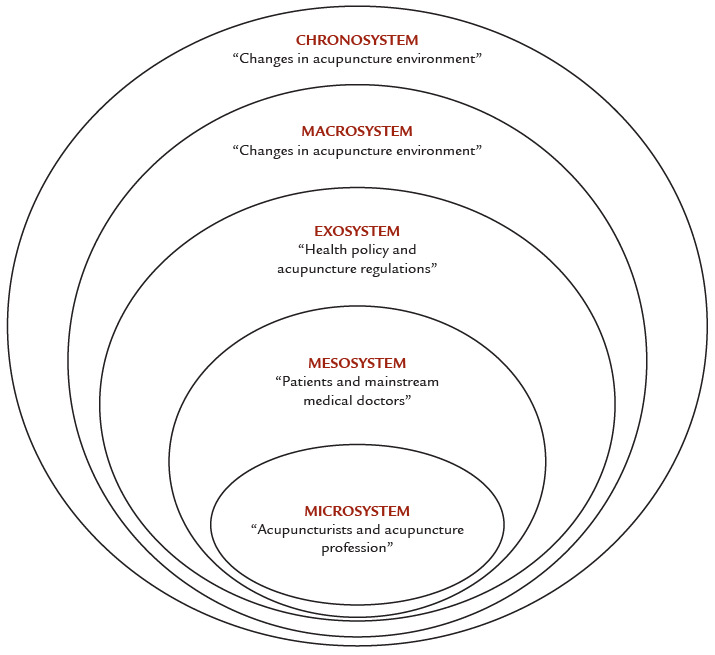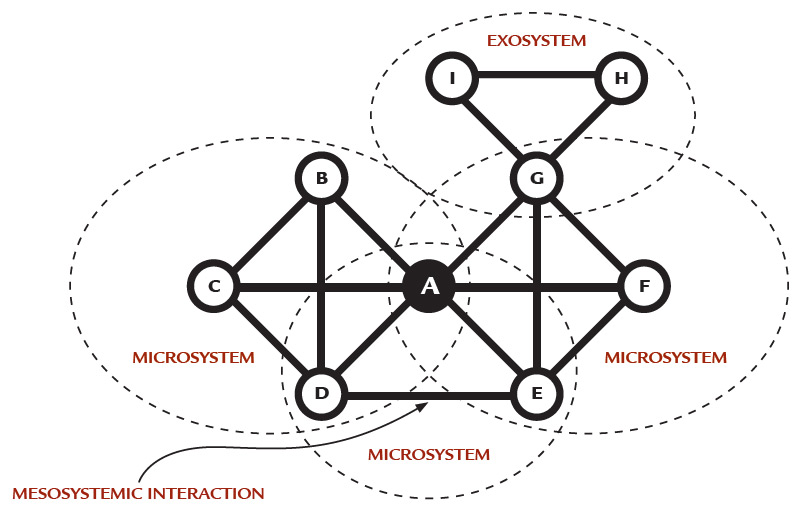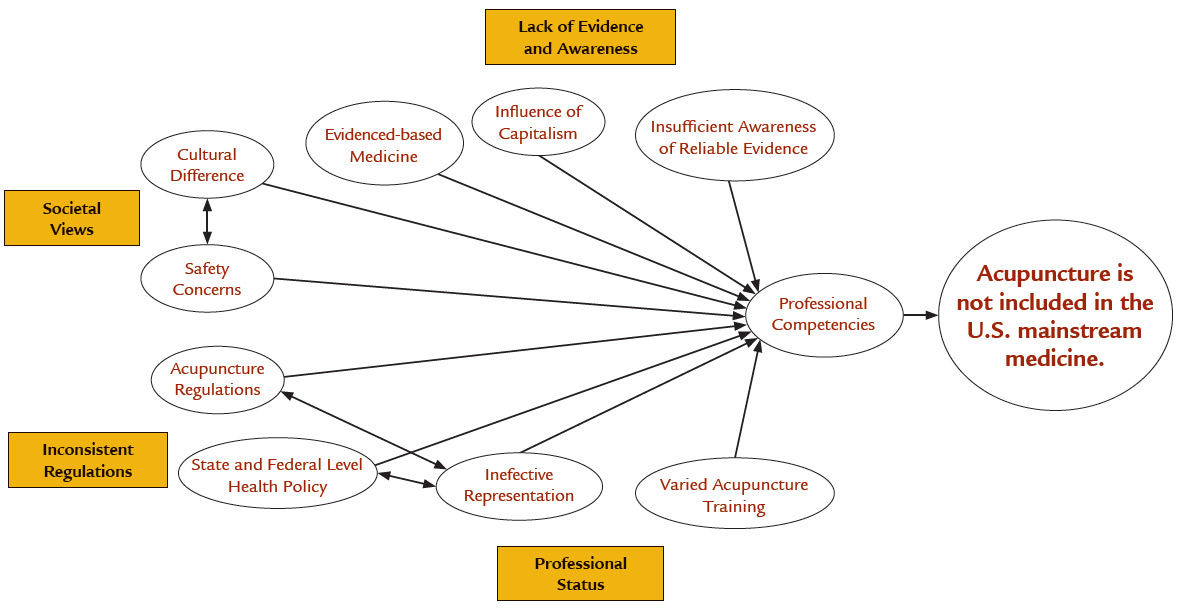One of the longest nerves in the body is known as the vagus nerve (VN). The VN is the 10th pair of cranial nerves that originates at the brain stem in the medulla oblongata. This nerve is part of the parasympathetic nervous system, which is a part of the ANS. Research suggests ear acupuncture can activate the VN.
Understanding the Challenges of U.S. Acupuncture Practice (Pt. 2)
The ecological systems theory (EST) provides the theoretical framework for this exploration of the literature. Bronfenbrenner’s (1979) notion that researchers should investigate a phenomenon within its ecological context deviated from previous research by developmental psychologists who focused on isolated behaviors without consideration of reciprocal or outside influences.1
Bronfenbrenner’s nested model situates the focal individual within concentric spheres of influence.1 The five systems in this model include the chronosystem, macrosystem, exosystem, mesosystem, and microsystem. External barriers to mainstreaming acupuncture fall within three systems — macrosystem, exosystem and mesosystem, whereas internal barriers reside within the mesosystem and microsystem. (Table 1, end of article)
To situate the nested model within the context of the problem of practice, each system is aligned with the appropriate underlying factor from the problem of practice in Figure 1.

According to Bronfenbrenner, as the spheres of influence move farther from the center, the influence of the proximal processes lessens. Proximal processes are defined as persistent influences that directly affect the immediate surroundings.2
For example, mainstream medical doctors, which as a factor is located in the mesosystem, would have a more immediate impact on mainstreaming acupuncture in the U.S. as compared to broader societal views on health, which as positioned in the macrosystem is farther removed from what directly happens.
The Neal and Neal Model: Focusing on Patterns of Social Interaction
Although developmental studies have traditionally used the nested model to contextualize predictors, Neal and Neal contend that Bronfenbrenner’s theoretical framework does not adequately address the relationships between systems that do not occur within each layer of the nested model.3
As a result, Neal and Neal envisioned a networked model that conceptualizes the context as overlapping and intersecting systems. The spheres of influence directly or indirectly impact the social interactions of individuals within and across different systems (Figure 2).

Like Bronfenbrenner’s model, Neal and Neal’s model uses similar terminology to delineate the systems: chronosystem, macrosystem, exosystem, mesosystem, and microsystem. However, a major difference between these two models is their approach to organizing each system.
Bronfenbrenner’s approach situates each system according to environmental and relational influences between each nested system; whereas in Neal and Neal’s approach, the networked model focuses on the patterns of social interactions of participants within and across the different systems.3 For the purposes of this review, Neal and Neal’s networked model serves as the theoretical framework.
Underlying Factors Related to the Problem of Acupuncture Practice
Using EST to frame the complex nature of the challenges of practice allows for the exploration of the influential underlying factors and causes. Neal and Neal’s networked model recognizes the interplay and overlap between the various systems.3
In this approach, societal views on health and safety concerns serve as the macrosystem. Health policy and acupuncture regulations constitute the exosystem. Evidence-based medicine, insufficient awareness to mainstream professionals, lack of consistent professional competencies, and influence of capitalism comprise the mesosystem. The varied acupuncture training and ineffective representation of the acupuncture profession form the microsystem; the microsystem is the main driving factor for the problem of practice (see Table 2, below table 1).
| Table 1: Comparison of the Nested and Networked Models as They Align to the Problem of Practice | ||||
| Construct | Nested (from Bronfenbrenner, 1979 & 1994) | Networked (from Neal and Neal, 2013) | Alignment to the Context of the Problem of Practice | |
| Ecological Environment | "nested arrangement of structures, each contained within the next" (Bronfenbrenner, 1979, p. 514) | "overlapping arrangement of structures, each directly or indirectly connected to the others by the direct and indirect social interactions of their participants" (Neal & Neal, 2013, p. 727) | U.S. Healthcare system | |
| Setting | "place, time, physical features, activity, participant, and role" (Bronfenbrenner, 1979, p. 514) | "a set of people engaged in social interaction, which necessarily occurs in, and is likely affected by the features of, a place" (Neal & Neal, 2013, p. 727) | Acupuncture practice and mainstream medicine including acupuncturists and mainstream medical doctors. | |
| Chronosystem | "the change or consistency over time not only in the characteristics of the person but also of the environment in which that person lives." (Bronfenbrenner, 1994, p. 1646) | "the observation that patterns of social interactions between individuals change over time, and that such changes impact the focal individual, both directly and by altering the configuration of ecological systems around him/her" (Neal & Neal, 2013, p. 724) | Sociohistorical conditions and time; History of acupuncture | |
| Macrosystem | "overarching institutional patterns of the culture or subculture" (Bronfenbrenner, 1979, p. 515) | "set of social patterns that govern the formation and dissolution of social interactions between individuals, and thus the relationship among ecological systems" (Neal & Neal, 2013, p. 729) | Societal views on health; safety concerns | |
| Exosystem | "extension of the mesosystem embracing other specific social structures, both formal and informal, that do not themselves contain the developing person but impinge upon or encompass the immediate settings in which that person is found" (Bronfenbrenner, 1979, p. 515) | "setting - or set of people engaged in social interaction - that does not include, but whose participants interact directly or indirectly with, the focal individual" (Neal & Neal, 2013, p. 728) | State- and federal-level health policy; varied acupuncture regulations | |
| Mesosystem | "interrelations among major settings containing the developing person at a particular point in his or her life" | "social interaction between participants in different setting that both include the focal individual" (Neal & Neal, 2013, p. 728) | Evidence-based medicine; insufficient awareness to mainstream professionals, lack of consistent professional competencies, and influence of capitalism | |
| Microsystem | "complex relations between the developing person and environment in an immediate setting containing the person" (Bronfenbrenner, 1979, p. 514) | "setting - or set of people engaged in social interaction - that includes the focal individual" (Neal & Neal, 2013, p. 728) | Acupuncturists, acupuncture practice, and entities related to acupuncture such as the varied acupuncture training and ineffective representation of acupuncture profession | |
| Table 2: Comparison of Health Professions Standards | ||||
| Profession | KSAs | Educational Conformity | National Practice Definition | National Scope of Practice |
| Medicine | 1880s | 1896 | 1920s | 1920s |
| Physician assistant | 2006 | 1986-1996 | 1965 | 1965 |
| Physical therapy | 1920s | 1950s-1977 | 1986 | 1986 |
| Nursing | 1917 | 1912-1952, 1969 | 1955 | 1972 |
| Chiropractic | 1981 | 1960s | No | No |
| Naturopathy | 1910-1930 | 1980s-1990s | No | No |
| Acupuncture | No | 1982-1985 | No | No |
Note. Data for the year of established KSAs, educational conformity, national practice definition, and national scope of practice from Stumpf et al. Acupuncture practice acts: A profession’s growing pains. The Journal of Science and Healing, 11, 219. doi:10.1016/j.explore.2015.02.002
The networked model appropriately addresses the relationships between entities and how acupuncturists, individually and collectively, respond to mainstreaming acupuncture. Figure 3 illustrates the conceptual framework for underlying factors and causes that contribute to the challenges of practice.

Mainstreaming the acupuncture profession is a complex endeavor. A myriad of factors, directly and indirectly, influence acupuncture’s integration into mainstream medicine in the United States. In subsequent parts of this article, each of the influences will be introduced using Neal and Neal’s networked model approach, starting with the chronosystem.3
Editor’s Note: Pt. 1 of this eight-part series appeared in the June issue.
References
- ronfenbrenner U. Contexts of child rearing: problems and prospects. Am Psychol, 1979;34:844.
- ronfenbrenner U. Ecology Models of Human Development. In: Postlewaite TN, Husen T (Eds.). International Encyclopedia of Education, 2nd Edition, Volume 3. Oxford, England: Elsevier, 1994: pp. 1643-1647.
- Neal JW, Neal ZP. Nested or networked? Future directions for ecological systems theory. Soc Dev, 2013;22:722–737.



